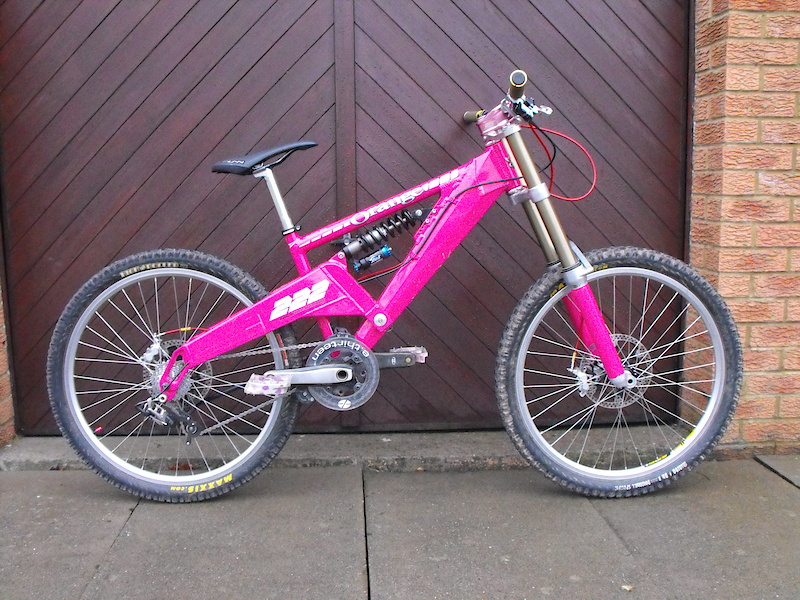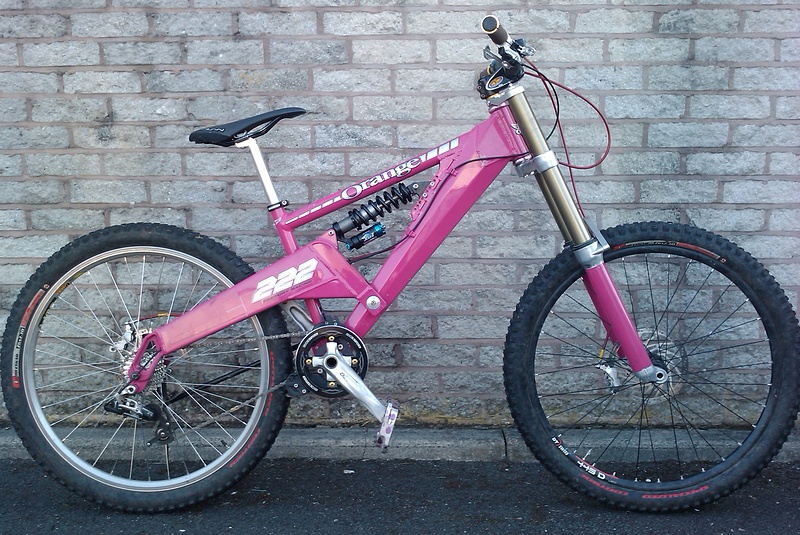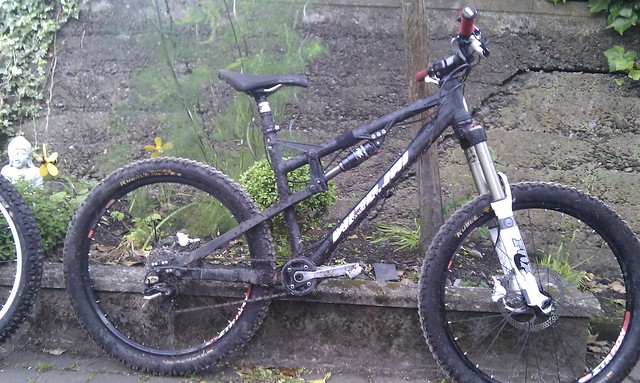- This topic has 32 replies, 21 voices, and was last updated 12 years ago by crashtestmonkey.
-
At what point does a bike become unrideable uphill?
-
rocketmanFree MemberPosted 12 years ago
Toying with the idea of a burly FR/DH-lite bike but I live 9 miles from the nearest DH runs and I would have to ride the bike on some lanes & red/blue trails to get there.
For those of you who have a slack 40lb single-ring bike with a road cassette, at what point do you have to get off and push? I’m guessing it’s any time the trail is not pointing downhill 😕
weeksyFull MemberPosted 12 years agoi have a mate who runs a pair of Bionicons that weigh in about that weight i rekon.. he has no trouble at all getting them up any hills.
nickfFree MemberPosted 12 years agoToying with the idea of a burly FR/DH-lite bike but I live 9 miles from the nearest DH runs and I would have to ride the bike on some lanes & red/blue trails to get there.
For those of you who have a slack 40lb single-ring bike with a road cassette, at what point do you have to get off and push? I’m guessing it’s any time the trail is not pointing downhill
I did Passportes Du Soleil on something heavier than that. I lost 3kg in the day. The problem is not so much when it’s steep (though sometimes climbs are impossible due to the gearing), it’s when you have long climbs. You just overheat.
slowriderFree MemberPosted 12 years agowhen you give up.
on the road it has to be a fairly sharp gradient to make you get off, particularly if you get a frame with the capicty for a full-length seat tube.
if you aren’t racing dh then a long travel/ mini dh bike will probably be just as much fun plus a few pounds lighter. you might not be quite as fast down ‘proper’ dh courses but chances are you will enjoy it more as they tend to be a bit more sprightly rather than a gravity assisted steamroller. I’m generalising massively here of course, but IMO as a non-racer who likes gravity based stuff, I had much more fun on a commencal mini dh and a patriot 66 than i did on a kona operator
chakapingFree MemberPosted 12 years agoIf you have to ride it 9 miles to get to the DH tracks, wouldn’t you consider getting a double ring and normal cassette?
That’s what I had on my Froggy and it was a shade under 40lbs I reckon.
It only really struggled with technical climbing – which I don’t think the Totem was designed for at all. Otherwise it was just a matter of going a fair bit slower.
(Selling frame and fork btw, email in profile if you fancy a bargain)
BoardinBobFull MemberPosted 12 years agoI can pedal my 37.5lb Reign X uphill fairly easily, and I’m a constant granny ring climber on any bike so I’m far from a strong climber.
xiphonFree MemberPosted 12 years agoMy 222 simply doesn’t go uphill.
I would go dual-ring (22/36?), and make sure your seatpost is long enough to stretch those leg muscles 🙂
Also, tyre choice is very important. SuperTacky’s will drag so much, you’ll want to push.
Pump your tyres nice and hard, then let them down a bit at the trails, then pump them back up again for the long ride home?
GWFree MemberPosted 12 years agoout of pure laziness (hardtail broke and not yet got round to fixing it) i’ve been riding my 37lb mini DH bike on our local 1-2hr XC nightrides recently. it has a single 36T ring with 11-30 cassette and supertacky Dual ply Highroller on the rear (again, pure laziness). I’ve managed to keep up no problem. the most important thing is having a seatpost that allows full extension for sat down pedalling. higher tyre pressures than you’d run DH helps too.
my actual DH bike is only 3lb heavier and shares almost exactly the same geometry but has more has travel and an 11-23 cassette. I physically couldn’t ride it round the same routesrocketmanFree MemberPosted 12 years agoHmm some encouraging comments thanks fellas.
I have an DJ bike that weighs 35lbs or so and I can ride that OK on an 11-32 cassette and a 32T chainring. Just trying to get an idea of how much difference another 5-10 lbs and higher gearing would make.
honourablegeorgeFull MemberPosted 12 years agoI’ve ridden my Demo 7 with tripls clamps on XC rides – if you stand on the pedals and mash it will go up just about anything (grip is huge), but on long fireroad climbs it’s a bit draggy and draining, but if you’re in no hurry, it’ll get there.
Something like an SX Trail or PAtriot might be a decent compromise. Or a mate with a van.
evilclosetmonkeyFree MemberPosted 12 years agoI had a scott high octane i used to pedal uphill but you do tend to overheat and after a day doing the ups and downs my knee’s were pretty gubbed.(Erm i’m not the fittest tho)
5labFull MemberPosted 12 years agowhy do you want a road casette on there? other than the absolute fastest racers I can’t see the closer ratios making any difference. I’ve done plenty of xc on my dh\play bike (45lbs, 36t front ring, 11-34 at the back) including sdw in a day. a road casette would have limited a lot of that
scruffFree MemberPosted 12 years agoYoull need something with a long seatpost which can be dropped right down. Yes you can pedal a heavy bike all day with low enough gearing but your knees will exlode with seat down and standing up will kill you. Keep a normal cassette on, maybe 60a tyre on back, ST on front.
ianpinderFree MemberPosted 12 years agoA road cassette allows you to run a smaller chainring giving you more clearence
5labFull MemberPosted 12 years agoA road cassette allows you to run a smaller chainring giving you more clearence
I don’t see how. Smallest cog on a road cassette is 11, smallest on a mtb cassette is 11. Smaller chainring requires some serious bodgery to get a 9t cassette (using a cassette\freehub from a folding bike or the as-yet-unreleased specialised system)
xiphonFree MemberPosted 12 years agoNo, he means the other end of the cassette.
i.e 28T max or something, means you can run 32/33/34/35/36 front chainring for the same ratio
5labFull MemberPosted 12 years agoNo, he means the other end of the cassette.
i.e 28T max or something, means you can run 32/33/34/35/36 front chainring for the same ratio
well, yeah, but then you lose some gears at the top end (a 11-28 will be 2 gears ‘short’ in range compared to a 11-34, but the gears themselves will be approximatey 20% closer together)
NorthwindFull MemberPosted 12 years agoWeight’s not so important, nor travel, IMO… Though obviously big bikes tend to be more active and squashy. Seatpost, gearing and tyres are though. I can ride my Ellsworth, very slowly, up pretty much anything I’d ride on my more sensible bikes- it’s got a proper length seatpost, a flat saddle, and a 34/11 cassette on it. Not exactly race spec but it works. Course, it’s still hard work and I mourn the loss of every watt into its squishyness.
xiphonFree MemberPosted 12 years agoRemember the days of DH, when 42T was ‘normal’ and a ‘normal’ MTB cassette (not road type) was used?
You get better clearance under the chainring.
42T bash
36T bash
5labFull MemberPosted 12 years agoright, but if you have a road casette, and a 36t chainring, you have the same ‘top’ gear as a mtb casette and a 36t chainring.
The big chainring era allowed cranking at higher speeds. This was more because of the types of DH trails back 10 years ago were generally faster and smoother, so ridden at higher speed.
road cassettes have advantages. Closer ratio gears allow the rider to be in a gear that is more ‘right’ for the speed they are doing. they also allow a shorter rear mech with less slack chain. However, if you’re not good enough to get increased performance from having your gears ever-so-slightly closer together, then you may as well run a mtb cassette (I’m rarely in the ‘optimum’ gear when riding dh, i tend to bung it in one gear and crank away).
Smaller front chainrings are an advantage. They are *not* an advantage of road casettes
messiahFree MemberPosted 12 years agoI used to ride this for what you are describing.
At about 45lbs it was a beast of a bike but it had super low gears and hence could be winched up almost anything – including a good few Munro’s.
I changed to this a year ago…
Which at 35lbs with a CCDB and Reverb is a hell of a lot more manageable and can be used as an everyday bike unlike the big beast, and it actually doesn’t stop me doing anything I used to do on the beast.
Something similar with 180 forks and the Hammerschmidt could be built at around 35-40lbs which would make it pretty damn useable. Hammerschmit is awesome for what you describe – never lose the chain but have a huge range of gears = brilliant… until the Pinion system comes out 🙄
JonEdwardsFree MemberPosted 12 years agoThere are plenty of bikes out there that can do that quite nicely.
New Orange Patriot is one, Reigh X another. I have an Uzzi (@35lb) and regularly drag it 30+ miles across the Peaks. Reckon I could single ring it over most things if I went 10 speed 34 + 11->36, and still have enough speed for the DH stuff.
The important things aren’t so much about tyres or weight for the climbing as seat angle and adjustable forks. A steepish seat angle plus the ability to drop the front end gives a not unpleasant climbing position, wind the forks down and get rid of the saddle and roost the downs. Sorted! It’ll never feel sprightly the way an xc bike does, but you’ll be able to winch up everything you feel the need to have a crack at.
messiahFree MemberPosted 12 years agoI’ve never found adjustable forks lengths like Talas/U-turn to be any benefit other than for finding the sweetspot travel length for a given frame. Lengthening travel for the downs and shortening for the climbs in my experience screws up how a bike feels. Find the fork length that works best for me on a frame and leave it at that is what I do.
D0NKFull MemberPosted 12 years agoI’ve never found adjustable forks lengths like Talas/U-turn to be any benefit other than for finding the sweetspot travel length for a given frame.
OTOH I’ve not used talas/uturn much but ETA on my bombers is fantastic. On steep ups it means sitting and spinning instead of leaning forwards trying to keep the front end down. But that’s me on my setup YMMV etc.
messiahFree MemberPosted 12 years ago@DONK Smooth climbs maybe 😉 … on the rock infested hell climbs near me when you use ETA you bash your pedals off the rocks 😆
_tom_Free MemberPosted 12 years agoI found I was able to ride my Bullit up most things I tried in and around Whistler. Weighs around 37lbs, has Boxxers and fairly draggy tyres. It has a granny ring though. The biggest problem is trying to keep the weight over the front, very easy to wheelie especially when you’re going up steeper techier stuff (not that I did much of that). A travel adjust fork would help a lot I think. I occasionally used a tie-down strap to pull in the travel and it was a lot easier to climb with.
rhidFull MemberPosted 12 years agoI did the same on my Bullit too. It was pretty decent at climbing up xc style stuff with 2 rings upfront.
I watched a pal ride his 224 relatively successfully on the trail from Les Gets to Morzine, it is pretty steep in sections. It wasn,t pretty but he managed it. I would have got off and pushed, theres no shame in that!
GWFree MemberPosted 12 years agoA road cassette allows you to run a smaller chainring giving you more clearence
No it doesn’t
road cassettes typically have a 12T smallest sprocket whereas even the largest ration mtb cassettes will have an 11Tsuper close ratio road cassettes don’t even make sense for DH racing, just means you’ll be double shifting more often to get a noticably higher/lower gear as gradient changes. using your head and chgoosing the optimum sprockets for what you actually need on DH race courses would result in a 5/6spd cassette at most and would include jumps of more than one sprocket tooth at a time in the middle/larger sprockets.
also, DH bike geometry shouldn’t be rear weight biased/wheelytastic on climbs as they are generally much longer/lower bikes than XC/AM bikes, if your DH bike is too light at the front to climb on it’s more likely to do with it either having awful geometry (Bullit) a bad set-up or too slack a seat-tube (as it was never meant to hold an XC height seatpost)
_tom_Free MemberPosted 12 years agoYeah I think the Bullit has something like a 68 degree seat angle. The rest of the geometry isn’t that bad though. It’s a fun bike to ride.
5labFull MemberPosted 12 years agothe bullet’s alright – its just dated in terms of mtb geometry. Its like many early 00’s freeride bikes – short and high, and relatively steep. Trouble is, they carried on selling it till earlier this year when everything else had changed..
crashtestmonkeyFree MemberPosted 12 years agobuilt a kona coiler (so only 130mm) for alps trip a few years ago. With dual ply super tacky minions on it weighed 38lbs 😯 Left it like that when I came back and rode it in the same build (eventually with slightly lighter and less draggy minions) all over the UK.
Weight and gearing is possibly less of a factor than geom/sus, my Mk1 Nomad despite weighing “only” 32lbs climbed like a pig in the granny. The Alpine (which is probably heavier) that replaced it is a much better climber.
Never used lockout on front or rear (disabled it on my Lyrik which is a popular mod to improve small bump response).
The topic ‘At what point does a bike become unrideable uphill?’ is closed to new replies.




